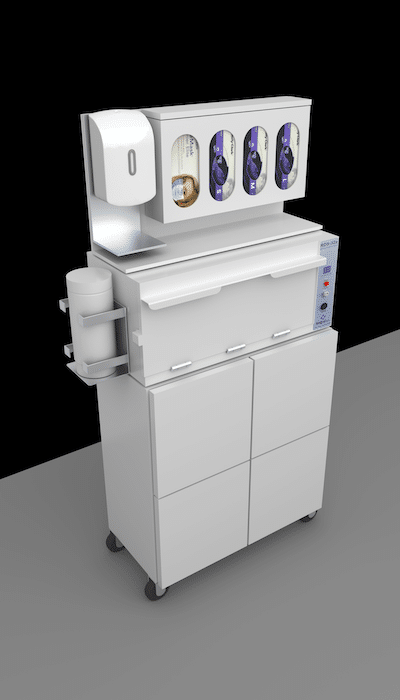Dealing with the COVID-19 Pandemic has taught us all that we were not prepared for this occurrence. Handwashing is the Bain of our existence in healthcare. Before the COVID-19 pandemic, adherence to handwashing was often lower than 42%. The Joint Commission and CMS have always made handwashing a major emphasis of their facility evaluations, yet many healthcare providers remain noncompliant. COVID-19 has certainly changed the landscape for handwashing, and again, we struggle to remain pathogen free due to the number of occurrences or opportunities where hand hygiene is desired and not performed.
As we continue in the health care arena, we must reconsider how we manage our patients as well as our devices and how our hands continually get re-contaminated. We do not have robust protocols for how to handle and disinfect our patient devices and other tools as we practice our medical specialties and care for our patients.
The data suggests that we all touch our faces at least twenty times per hour, touch inanimate objects, touch soft and hard surfaces, and sometimes we wash our hands. Even when we disinfect our patient care equipment before entry, within the patients’ room we contaminate the devices and do not clean them. The use of bedside equipment and the disinfection thereof has traditionally been with disinfectant wipes and more wipes. Issues with wipes are confusing…What do we use, when do we use it, for how long, and does it make a difference? Our patients are using wipes too, with 99.9% (3-log kill), do they really make a difference in their homes? Are we just spreading more bacteria and viruses? Are we damaging electronic equipment and giving ourselves a false sense of security?
Recent articles suggest that the spotlight is shining on Healthcare Administrators and Infection Control Managers.
“The burden is on them to identify weaknesses and danger zones within their hospitals, not only to improve patient and employee safety, but to reduce the spread of infections and thwart any financial penalties Medicare might impose on their organizations in the months and years ahead.”¹
A SHEA Town Hall has recently stated (March 2022) that we need to re-engage our workforce…we need to get back to basics. Healthcare turnover has led to a staff that is not necessarily in tune with current hospital protocols. The use of travelers has further widened the knowledge gap. Are protocols even up to date?
Is there a better way?
Electronic devices, point of care devices, etc. are all used on multiple patients. Staff handle them with their hands or contaminated gloves and rarely does anyone consider this in their daily practice. The use of a rapid decontamination device for inanimate objects can lower the endemic load of pathogens.
We need to pursue a different disinfection model across health care. We need it to be efficient and reliable and done at a reasonable cost.
“To be effective great attention is required on the 4 C’s, Chemistry, Concentration, Coverage, and Contact Time. The two C’s most often challenged are Coverage and Contact Time. Most disinfectants are transparent, making it difficult to confirm complete coverage on treated surfaces and most surfaces in healthcare are waterproof making it almost impossible to keep the surface wet. What makes this poor coverage such a big issue is the contact time. If two-thirds of the surface fails to be covered a few seconds after you apply the disinfectant, then most of the surface will not be properly disinfected even if you wait until the correct contact time. ² Everyone including APIC members and Infection Control Managers surveyed agrees that compliance is an age-old problem. No one is carrying around stopwatches to make sure they’re waiting for the correct contact time. Just because a disinfectant was put on a surface does not mean that pathogens will be removed or killed.”
The use of a simple disinfection instrument can lend a hand to this problem and reduce costs.
UVC systems have been used successfully for several years to achieve total room disinfection. Robots, however, do not provide the repetitive fast-cycle disinfection of handheld equipment, devices, tools and supplies. The recent development of desktop UVC disinfection cabinets can.
The system I have experience with is the RDS-32a system from TMG Health Technologies.
The RDS-32a is an EPA Registered, one-touch UVC rapid decontamination system designed to disinfect hundreds of sensitive electronics, keyboards, tools, office supplies, and personal effects at a cost less than a sanitation wipe.
The patented M²D Technology guarantees high-level deactivation up to a 6 Log₁₀ efficacy or 99.9999% of the COVID-19 viruses and other major pathogens.
The company just launched its new RDS Sanitation Station, which combines hand hygiene, PPE, and equipment disinfection in a single 30-Second cycle.
Statistics prove that combining hand hygiene with equipment disinfection greatly improves compliance scores, reduces sanitation and waste costs, saves time, and results in a lower transmission of HAI-causing organisms.
The protocol is simple. Contaminated non-critical patient objects to be placed in a UVC unit as follows:

1. HCW takes patient care instruments and places them in the UVC unit. A 30-Second cycle is activated.
2. HW removes gloves and performs hand sanitizing.
3. HW dons gloves and removes items from UVC cabinet and enters patient room.
4. HCW needs to place instruments on a “clean field” if to be used more than once. Care must be taken not to touch the face or other objects while doing patient care.
It’s obvious, that a simple UVC solution will lead to fewer infections and lower costs…savings on wipes and shorter hospital stays.
We have no more excuses.
References:
1. New Study Reveals Limitations of Disinfectants Performance.”, Cleanroom Technology Magazine JUL 2017
2. Efficacy of disinfectant-impregnated wipes used for surface disinfection in hospitals: Song, X., Vossebein L., Zille, A

